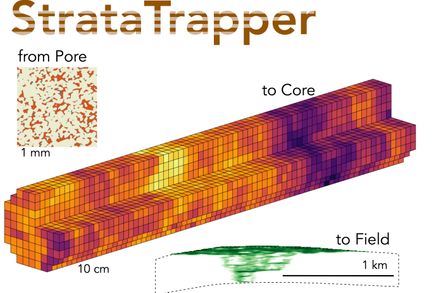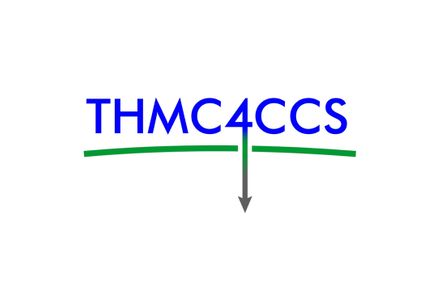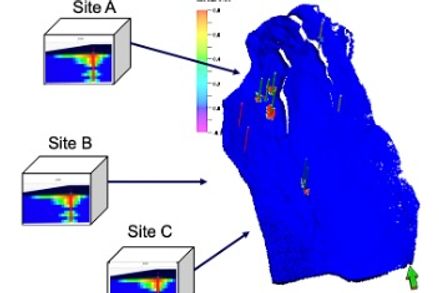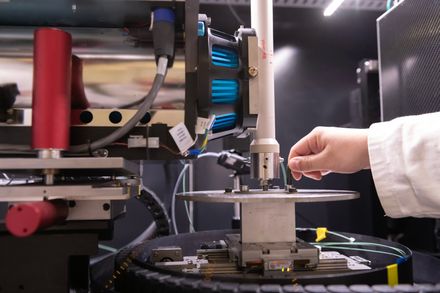We investigate the physics, chemistry, and techno-economics of CO2 storage underground
Our research includes exploring fundamental pore scale fluid dynamics, developing digital rocks analysis techniques, increasing the accuracy of field scale reservoir simulation, and evaluating the feasibility of scaling up CO2 storage to climate relevant scales.
Our Research Projects

StrataTrapper Advanced Modelling of CO2 Migration and Trapping

THMC4CCS: ThorougH experiMental and numerical investigation of Coupled processes for geologiC Carbon Storage
Results
- Showing results for:
- Reset all filters
Search results
-
Journal articleGarfi G, John CM, Rucker M, et al., 2022,
Determination of the spatial distribution of wetting in the pore networks of rocks
, JOURNAL OF COLLOID AND INTERFACE SCIENCE, Vol: 613, Pages: 786-795, ISSN: 0021-9797- Author Web Link
- Cite
- Citations: 9
-
Journal articleZhang Y, Jackson C, Zahasky C, et al., 2022,
European carbon storage resource requirements of climate change mitigation targets
, INTERNATIONAL JOURNAL OF GREENHOUSE GAS CONTROL, Vol: 114, ISSN: 1750-5836- Author Web Link
- Cite
- Citations: 4
-
Journal articleGarfi G, John C, Rücker M, et al., 2022,
Determination of the spatial distribution of wetting in the pore networks of rocks
<jats:p>The macroscopic movement of subsurface fluids involved in CO2 storage, groundwater, and petroleum engineering applications is controlled by interfacial forces in the pores of rocks, micrometre to millimetre in length scale. Recent advances in physics based models of these systems has arisen from approaches simulating flow through a digital representation of the complex pore structure. However, further progress is limited by a lack of approaches to characterising the spatial distribution of the wetting state within the pore structure. In this work, we show how observations of the fluid coverage of mineral surfaces within the pores of rocks can be used as the basis for a quantitative 3D characterisation of heterogeneous wetting states throughout rock pore structures. We demonstrate the approach with water-oil fluid pairs on rocks with distinct lithologies (sandstone and carbonate) and wetting states (hydrophilic, intermediate wetting, or heterogeneously wetting). The resulting 3D maps can be used as a deterministic input to pore scale modelling workflows and applied to all multiphase flow problems in porous media ranging from soil science to fuel cells.</jats:p>
-
Journal articleHarris C, Jackson SJ, Benham GP, et al., 2021,
The impact of heterogeneity on the capillary trapping of CO2 in the Captain Sandstone
, International Journal of Greenhouse Gas Control, Vol: 112, Pages: 1-12, ISSN: 1750-5836A significant uncertainty which remains for CO2 sequestration, is the effect of natural geological heterogeneitiesand hysteresis on capillary trapping over different length scales. This paper uses laboratory data measured incores from the Goldeneye formation of the Captain D Sandstone, North Sea in 1D numerical simulations toevaluate the potential capillary trapping from natural rock heterogeneities across a range of scales, from cm to65m. The impact of different geological realisations, as well as uncertainty in petrophysical properties, on theamount of capillary heterogeneity trapping is estimated. In addition, the validity of upscaling trapping characteristics in terms of the Land trapping parameter is assessed. The numerical models show that the capillaryheterogeneity trapped CO2 saturation may vary between 0 and 14% of the total trapped saturation, dependingupon the geological realisation and petrophysical uncertainty. When upscaling the Land model from core-scaleexperimental data, using the maximum experimental Land trapping parameter could increase the expectedheterogeneity trapping by a factor of 3. Conversely, depending on the form of the imbibition capillary pressurecurve used in the numerical model, including capillary pressure hysteresis may reduce the heterogeneity trapping by up to 70%.
-
Journal articleWenck N, Jackson SJ, Manoorkar S, et al., 2021,
Simulating Core Floods in Heterogeneous Sandstone and Carbonate Rocks
, WATER RESOURCES RESEARCH, Vol: 57, ISSN: 0043-1397- Author Web Link
- Cite
- Citations: 5
-
Journal articleManoorkar S, Jackson SJ, Krevor S, 2021,
Observations of the Impacts of Millimeter- to Centimeter-Scale Heterogeneities on Relative Permeability and Trapping in Carbonate Rocks
, WATER RESOURCES RESEARCH, Vol: 57, ISSN: 0043-1397- Author Web Link
- Cite
- Citations: 7
-
Journal articleSpurin C, Bultreys T, Rücker M, et al., 2021,
The development of intermittent multiphase fluid flow pathways through a porous rock
, Advances in Water Resources, Vol: 150, Pages: 1-7, ISSN: 0309-1708storage and natural gas production. However, due to experimental limitations, it has not been possible to identify why intermittency occurs at subsurface conditions and what the implications are for upscaled flow properties such as relative permeability. We address these questions with observations of nitrogen and brine flowing at steady-state through a carbonate rock. We overcome previous imaging limitations with high-speed (1s resolution), synchrotron-based X-ray micro-computed tomography combined with pressure measurements recorded while controlling fluid flux. We observe that intermittent fluid transport allows the non-wetting phase to flow through a more ramified network of pores, which would not be possible with connected pathway flow alone for the same flow rate. The volume of fluid intermittently fluctuating increases with capillary number, with the corresponding expansion of the flow network minimising the role of inertial forces in controlling flow even as the flow rate increases. Intermittent pathway flow sits energetically between laminar and turbulent through connected pathways. While a more ramified flow network favours lowered relative permeability, intermittency is more dissipative than laminar flow through connected pathways, and the relative permeability remains unchanged for low capillary numbers where the pore geometry controls the location of intermittency. However, as the capillary number increases further, the role of pore structure in controlling intermittency decreases which corresponds to an increase in relative permeability. These observations can serve as the basis of a model for the causal links between intermittent fluid flow, fluid distribution throughout the pore space, and the upscaled manifestation in relative permeability.
-
Journal articleWenck N, Jackson SJ, Muggeridge AH, et al., 2021,
Characterisation and Modelling of Heterogeneous Sandstone and Carbonate Rocks
-
Journal articleDe Simone S, Krevor S, 2021,
A tool for first order estimates and optimisation of dynamic storage resource capacity in saline aquifers
, International Journal of Greenhouse Gas Control, Vol: 106, Pages: 1-11, ISSN: 1750-5836The importance of carbon capture and storage in mitigating climate change has emerged from the results of techno-economic or integrated assessment modeling, in which scenarios of future energy systems are developed subject to constraints from economic growth and climate change targets. These models rarely include limits imposed by injectivity, ultimate amounts, or the geographic distribution of storage resources. However, they could if a sufficiently simple model were available. We develop a methodology for the fast assessment of the dynamic storage resource of a reservoir under different scenarios of well numbers and interwell distance. The approach combines the use of a single-well multiphase analytical solution and the superposition of pressure responses to evaluate the pressure buildup in a multiwell scenario. The injectivity is directly estimated by means of a nonlinear relationship between flow-rate and overpressure and by imposing a limiting overpressure, which is evaluated on the basis of the mechanical parameters for failure. The methodology is implemented within a tool, named CO2BLOCK, which can optimise site design for the numbers of wells and spacing between wells. Given its small computational expense, the methodology can be applied to a large number of sites within a region. We apply this to analyse the storage potential in the offshore of the UK. We estimate that 25–250 GtCO2 can be safely stored over an injection time interval of 30 years. We also demonstrate the use of the tool in evaluating tradeoffs between infrastructure costs and maximising injectivity at two specific sites in the offshore UK.
-
Journal articleAndrews E, Muggeridge A, Garfi G, et al., 2021,
Pore-Scale X-ray Imaging of Wetting Alteration and Oil Redistribution during Low-Salinity Flooding of Berea Sandstone
, ENERGY & FUELS, Vol: 35, Pages: 1197-1207, ISSN: 0887-0624- Author Web Link
- Cite
- Citations: 12
This data is extracted from the Web of Science and reproduced under a licence from Thomson Reuters. You may not copy or re-distribute this data in whole or in part without the written consent of the Science business of Thomson Reuters.



